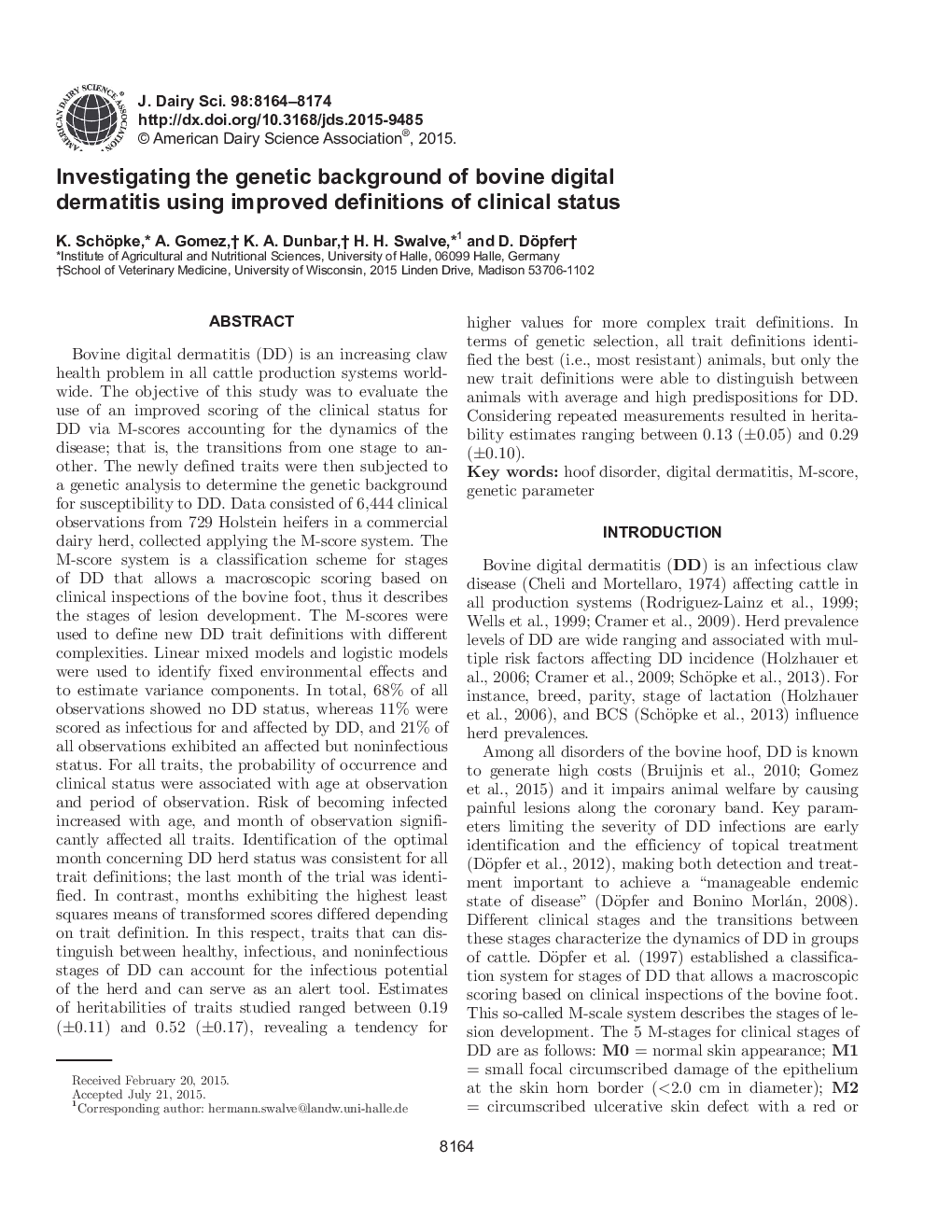| کد مقاله | کد نشریه | سال انتشار | مقاله انگلیسی | نسخه تمام متن |
|---|---|---|---|---|
| 10974587 | 1108026 | 2015 | 11 صفحه PDF | دانلود رایگان |
عنوان انگلیسی مقاله ISI
Investigating the genetic background of bovine digital dermatitis using improved definitions of clinical status
ترجمه فارسی عنوان
بررسی زمینه ژنتیکی درماتیت دیجیتال گاو با استفاده از تعاریف پیشرفته وضعیت بالینی
دانلود مقاله + سفارش ترجمه
دانلود مقاله ISI انگلیسی
رایگان برای ایرانیان
کلمات کلیدی
موضوعات مرتبط
علوم زیستی و بیوفناوری
علوم کشاورزی و بیولوژیک
علوم دامی و جانورشناسی
چکیده انگلیسی
Bovine digital dermatitis (DD) is an increasing claw health problem in all cattle production systems worldwide. The objective of this study was to evaluate the use of an improved scoring of the clinical status for DD via M-scores accounting for the dynamics of the disease; that is, the transitions from one stage to another. The newly defined traits were then subjected to a genetic analysis to determine the genetic background for susceptibility to DD. Data consisted of 6,444 clinical observations from 729 Holstein heifers in a commercial dairy herd, collected applying the M-score system. The M-score system is a classification scheme for stages of DD that allows a macroscopic scoring based on clinical inspections of the bovine foot, thus it describes the stages of lesion development. The M-scores were used to define new DD trait definitions with different complexities. Linear mixed models and logistic models were used to identify fixed environmental effects and to estimate variance components. In total, 68% of all observations showed no DD status, whereas 11% were scored as infectious for and affected by DD, and 21% of all observations exhibited an affected but noninfectious status. For all traits, the probability of occurrence and clinical status were associated with age at observation and period of observation. Risk of becoming infected increased with age, and month of observation significantly affected all traits. Identification of the optimal month concerning DD herd status was consistent for all trait definitions; the last month of the trial was identified. In contrast, months exhibiting the highest least squares means of transformed scores differed depending on trait definition. In this respect, traits that can distinguish between healthy, infectious, and noninfectious stages of DD can account for the infectious potential of the herd and can serve as an alert tool. Estimates of heritabilities of traits studied ranged between 0.19 (±0.11) and 0.52 (±0.17), revealing a tendency for higher values for more complex trait definitions. In terms of genetic selection, all trait definitions identified the best (i.e., most resistant) animals, but only the new trait definitions were able to distinguish between animals with average and high predispositions for DD. Considering repeated measurements resulted in heritability estimates ranging between 0.13 (±0.05) and 0.29 (±0.10).
ناشر
Database: Elsevier - ScienceDirect (ساینس دایرکت)
Journal: Journal of Dairy Science - Volume 98, Issue 11, November 2015, Pages 8164-8174
Journal: Journal of Dairy Science - Volume 98, Issue 11, November 2015, Pages 8164-8174
نویسندگان
K. Schöpke, A. Gomez, K.A. Dunbar, H.H. Swalve, D. Döpfer,
